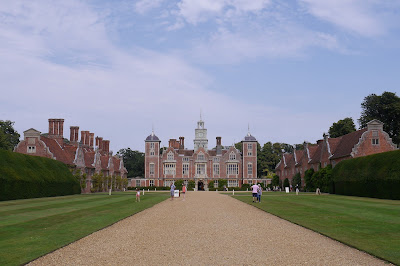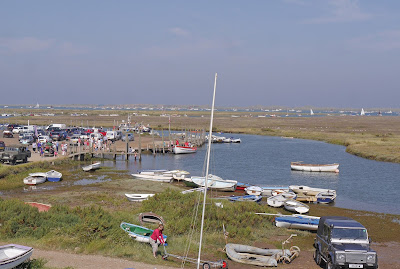The Town Hall and Guildhall
We are on our way home from an excellent few days in Norfolk and have decided to take a quick look at King's Lynn on the way. It is soon obvious that it deserves much more time than we have available. The town was was originally called Bishop's Lynn when it was founded by the Bishop of Norwich, Herbert de Losinga in 1093. It was one of England's busiest ports in medieval times. The name was changed to King's Lynn at the Reformation.
We had picked up a town trail map at our hotel in Blakeney and started our walk in the Saturday Market Place and admired the Town Hall and Guildhall complex (there is also the 18th century gaol just out of shot to the right). The Guildhall, on the right, was built for the Guild of Holy Trinity in 1422-28. The Town Hall harmonises well with it, although it dates only from 1895.
More or less opposite is the church of St Margaret, recently renamed King's Lynn Minster. It was founded in the 12th century and rebuilt in the 13th. The nave was substantially rebuilt in the 1740s after storm damage. I especially liked the great arches under the crossing.
Turning left out of the church brought us the the entrance to Nelson St. The building on the right is known as Hampton Court.
A simple gateway reveals a fascinating courtyard made up of four separate ranges developed from the 14th to the 17th centuries.
We walked along Priory Lane past cottages restored from the remains of a Benedictine monastery and right into Church St to reach the start of Nelson St, with Marriott's Warehouse on the left.
Nelson St is very picturesque and is apparently often used as a film set - it is conspicuously lacking in modern street furniture. It is a lovely street with buildings from many periods - and remarkably quiet.
At the end of the street, passing Hampton Court on the left, we turn into St Margaret's Lane, with teh Georgian St Margaret's House on the right and the half-timbered Hanseatic warehouse behind it. (King's Lynn was a member of the Hanseatic League, the commercial and defensive confederation of merchant guilds and their market towns which was influential between about 1400-1800. We saw Baltic examples of Guild buildings in Riga and Tallinn recently.)
This brought us out on the spacious South Key, with the wide River Ouse flowing by.
We headed back into the town along College Lane to find a nice view of the facade of St Margaret's and then walked along Queen St past Thoresby College, founded in 1500.
Opposite is Burkitt Homes of 1909, its dramatic red brick Gothic slightly out of place in this street.
Queen St passes the Custom House (1683) on the quay on the left (currently under restoration) and leads into King St, where St George's Guildhall can be found on the left. The coffee shop in the undercroft was open, but unfortunately the 15th century Guildhall itself was closed.
King St leads into the wide expanse of Tuesday Market Place, seemingly the palce to find a lawyer of a financial adviser. The most striking building is the Corn Exchange of 1854, converted to a concert hall in 1996.
We crossed the square and headed towards St Nicholas's chapel. We got a shock when we reached it to be greeted by what looks like a substantial parish church. Pevsner explains that it was founded as a chapel of ease in 1146, but almost wholly rebuilt in 1419. The lead spire is by Sir George Gilbert Scott (1869).
Inside there is single large airy space. Attention is focused upwards when the roof has angels as hammerbeams. Most are playing a musical instrument like this lyre. Rather sadly, the church is now redundant but enthusiastic volunteers will tell you all about it and collect donations for its upkeep.
At this point we had to face the fact that we did not have time to complete our walk around this lovely town. Instead, we headed briskly to the main car park and headed off into the Friday afternoon traffic.
Conditions: hot and sunny.
Distance: 2-3 miles.
Rating: four stars.
























































